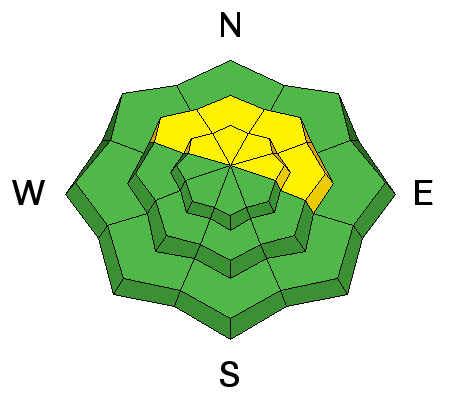25th Annual Black Diamond Fall Fundraising Party
Thursday, September 13; 6:00-10:00 PM; Black Diamond Parking Lot

25th Annual Black Diamond Fall Fundraising Party
Thursday, September 13; 6:00-10:00 PM; Black Diamond Parking Lot
| Advisory: Ogden Area Mountains | Issued by Paige Pagnucco for Thursday - January 4, 2018 - 6:26am |
|---|
 |
special announcement Spend some time improving your rescue skills or learning about avalanches in these two, upcoming Ogden area classes: January 12, 2018 Companion Rescue Fundamentals Snowbasin January 18, 2018 Backcountry 101 Avalanche Class Snowbasin There's also a Motorized Backcountry 101 class in Logan tonight and Saturday. Details and registration online. Episode 2 of the UAC podcast has been released. Drew Hardesty talks Avalanche Weather with Professor Powder himself, atmospheric sciences professor and author of Secrets of the Greatest Snow on Earth, Jim Steenburgh. Check it out on ITunes, Stitcher, the UAC blog, or wherever you get your podcasts. |
 |
current conditions Under mostly clear skies, mountain temperatures are currently in the low to mid 30's F with light winds. Riding conditions in the Ogden zone are a mixed bag of wind buff, soft snow, sun crusts and whatever else you can imagine. Variable to say the least. There are some areas with soft settled snow in sheltered terrain. Overall depth remains around 2-3 feet. If you are on a sled or bike, be mindful that large rocks and trees are lurking just under the snow surface. Ride with caution if you head off the beaten path. |
 |
recent activity It has been almost a week since any new avalanche activity has been reported though there were some close calls after the Christmas storm. See the avalanche list here. Recent Ogden area mountain observations are here. For perspective, it's worth noting the numbers and types of avalanches involved in avalanche fatalities since the winter of 1996/1997. (This was the winter Considerable was added to the danger scale). Those that perceive 'Moderate as the new Low' may be surprised at the numbers. P/D (in blue) are Persistent and Deep Slab avalanches. For moderate danger anyway, you'll see that these two account for half of the fatalities while accounting for only two-ninths of the stable of avalanche problems. For more info on the avalanche problems, check out the Avalanche Problem Toolbox.
|
| type | aspect/elevation | characteristics |
|---|


|


|

LIKELIHOOD
 LIKELY
UNLIKELY
SIZE
 LARGE
SMALL
TREND
 INCREASING DANGER
SAME
DECREASING DANGER
|
|
description
Though snowpit tests are offering inconsistent results, we are, in general, trending towards increased stability. But, given the poor structure of the snowpack, there are still some slopes where you can trigger an avalanche. Persistent weaknesses take time to heal - a little more time is needed before we have green light conditions. Approach steep slopes facing northwest through east at mid and high elevations with caution - evaluate the snow and terrain carefully. Sheltered, lower angle slopes offer better riding conditions anyway. Remember, unlike for other types of avalanche problems, ski cuts, cornice drops, and test pits can be unreliable pieces of information for persistent slab avalanches: use them to mark a slope as suspect, but not the other way around. The faceted, weak layers are easy to spot under the Christmas storm snow.
|
 |
weather Like a broken record ...We'll have mostly sunny skies today with mountain temperatures reaching into the 40's F and light southerly winds. The Saturday/Saturday night storm will hopefully bring a few inches of snow to our measly snowpack. Every little bit helps. In the mean time, I hear the ice skating on Pine View is 5 star. |
| general announcements CLICK HERE FOR MORE GENERAL INFO AND FAQ To get help in an emergency (to request a rescue) in the Wasatch, call 911. Be prepared to give your GPS coordinates. Backcountry Emergencies. It outlines your step-by-step method in the event of a winter backcountry incident. If you trigger an avalanche in the backcountry, but no one is hurt and you do not need assistance, please notify the nearest ski area dispatch to avoid a needless response by rescue teams. Thanks.
This information does not apply to developed ski areas or highways where avalanche control is normally done. This advisory is from the U.S.D.A. Forest Service, which is solely responsible for its content. This advisory describes general avalanche conditions and local variations always occur. |